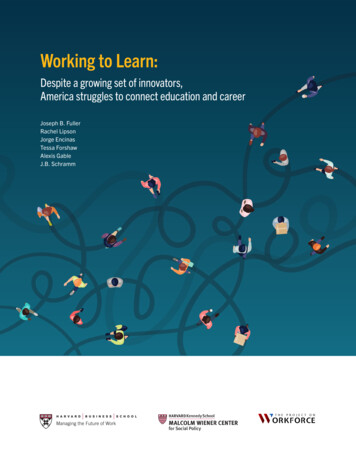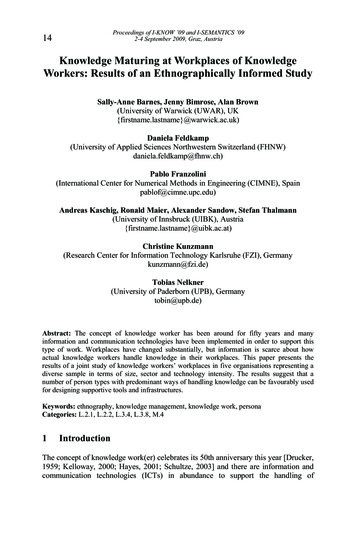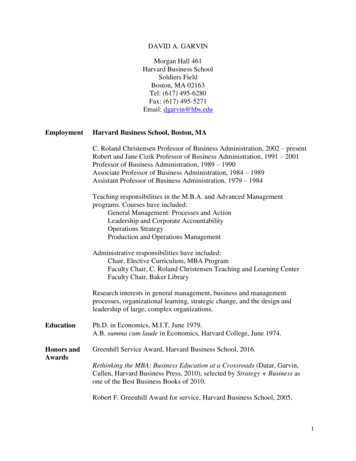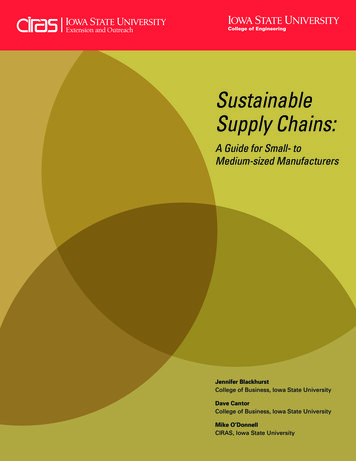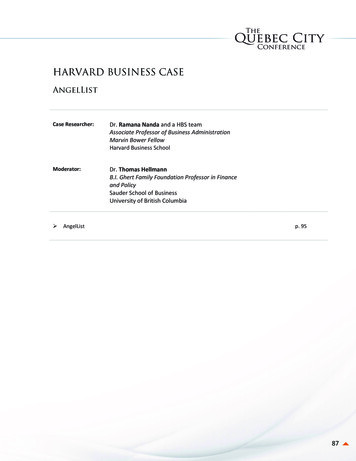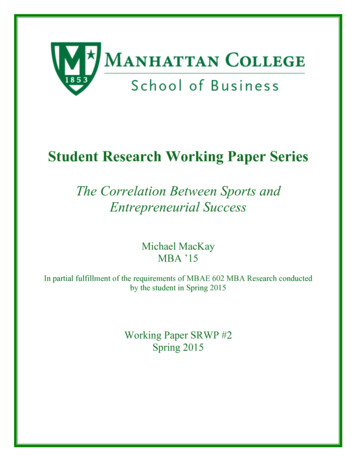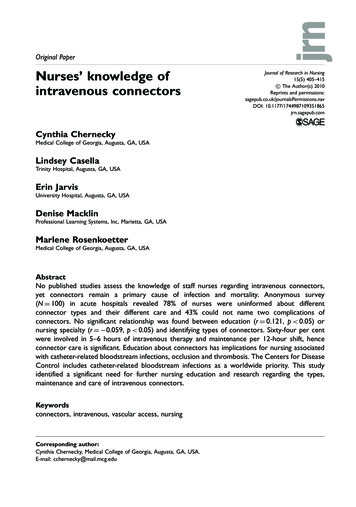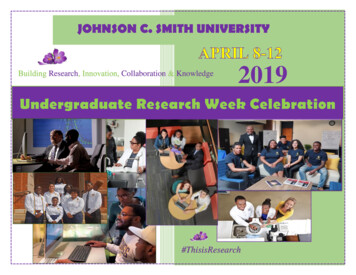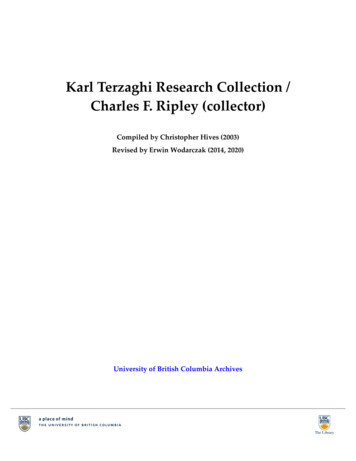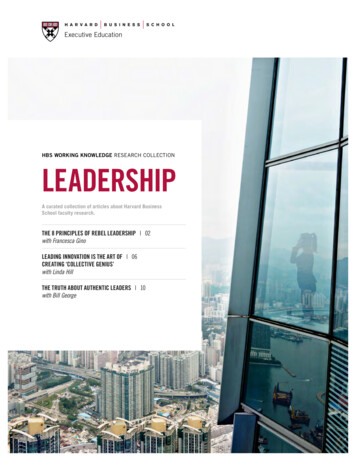
Transcription
HBS WORKING KNOWLEDGE RESEARCH COLLECTIONLEADERSHIPA curated collection of articles about Harvard BusinessSchool faculty research.THE 8 PRINCIPLES OF REBEL LEADERSHIP 02with Francesca GinoL EADING INNOVATION IS THE ART OF 06CREATING ‘COLLECTIVE GENIUS’with Linda HillTHE TRUTH ABOUT AUTHENTIC LEADERS 10with Bill George
LEADERSHIP HOW TO BE A REBEL LEADER—THE 8 PRINCIPLES OF REBEL LEADERSHIPHOW TO BE AREBEL LEADERTHE 8 PRINCIPLES OFREBEL LEADERSHIPAuthor Interview by Carmen Nobel“When I think ofrebels, I think ofpeople who breakrules to explore newideas and createpositive change.”On a fateful visit to the Harvard Coopin Cambridge, Massachusetts, FrancescaGino came across a cookbook calledNever Trust a Skinny Italian Chef. Writtenby Massimo Bottura, chef and owner ofthe Michelin three-star-rated restaurantOsteria Francescana in Modena, Italy,the book was filled with nontraditionaltakes on traditional Italian dishes. Therecipes astonished Gino, who grew up inItaly, where culinary traditions are amatter of great national pride.“In Italy, you’re not supposed to messaround with traditions in general, especiallywhen they are about recipes that havebeen passed on for generations,” saysGino, the Tandon Family Professor ofBusiness Administration and co-headof the Negotiation, Organization andMarkets Unit at Harvard Business School.“You just don’t do that! And yet, hereHBS EXECUTIVE EDUCATION WORKING KNOWLEDGE RESEARCH COLLECTIONwas a person, a rebel, who hadfound success by breaking rules andbreaking traditions.”Curiosity piqued, Gino, who is abehavioral scientist, embarked on aquest to find successful rebels. She flewto Italy to meet Bottura. She interviewedChesley Sullenberger, the airline pilotwho landed a 150,000-pound jetlineron top of the Hudson River after hisplane lost both engines in a bird strike.She wrote about Ava DuVernay, thegroundbreaking film director of Selmaand A Wrinkle in Time. She studied the18th-century pirate Blackbeard, whoseship, she says, “was arguably moredemocratic than America was at thetime.” And she considered her youngson, Alex, who puts red food coloringin his milk sometimes, just to shakeup his breakfast routine.The stories of many successful rebels,the lessons they impart, and thebehavioral science behind theselessons are collected in Gino’s book,Rebel Talent: Why It Pays to Break theRules at Work and in Life. In the book,Gino argues that business leadersshould strive for and encouragerebellion in their workplaces. And shemakes the case that rebellion wouldmake life more fulfilling for all of us.“When I think of rebels, I think of peoplewho break rules to explore new ideasand create positive change,” Gino says.“These are people who are doing goodin the world.”01SEEK OUT THE NEW:“It’s very easy for us all to fall back intoroutines and mindlessly follow them, dayafter day,” Gino says. “What this principleallows us to do, even in situations whereroutines and traditions exist, is to breakaway from them and find inspiration.”2
LEADERSHIP HOW TO BE A REBEL LEADER—THE 8 PRINCIPLES OF REBEL LEADERSHIPFor business leaders, this could meanintroducing employees to things that aren’tobviously related to the organization.Consider Chef Bottura’s dishes, whichare often inspired by music and visualarts. (“Tribute to Thelonious Monk,” forexample: black cod served with whitedaikon radish and green onion on a bedof squid ink, meant to represent the jazzmusician’s keyboard.) Bottura aims toinspire his staff by playing music in thekitchen during meal prep and hangingpaintings throughout the restaurant.“Even in the staff bathroom, you haveprints of different pieces of art,” Gino says.“And the reason that the art is thereis that when you look at it, you startasking questions.”02ENCOURAGE CONSTRUCTIVEDISSENT:“As humans, we often focus on just oneperspective, and generally it’s our own,”Gino says. “Whether it’s in conversationsor in meetings, we often seek out theopinions of people who have somethingsimilar to offer. What rebels do is fightthat instinct. They find ways to steer someconflict or encourage disagreement.”Gino cites Rachael Chong, CEO of theNew York-based nonprofit organizationCatchafire, who seeks out dissentingopinions from her workforce from theget-go, including when she interviewsjob candidates. “When she hires newpeople, she basically looks for peoplewho disagree with her,” Gino says.03OPEN CONVERSATIONS,DON’T CLOSE THEM:“Rebels are willing to keep their mindsopen,” says Gino, who recommendsthat business leaders take a cue fromthe world of improvisational comedy.A cardinal rule in improv is that oneperson must always accept the premiseof whatever another person says, andthen expand upon the thought, suchas saying, “yes, and ” rather than“yes, but.” At Pixar, this techniqueis called “plussing.” Gino explains howit works in Rebel Talent: “The point ofplussing is to improve ideas withoutusing judgmental language. You add to,or ‘plus,’ what has been said. Instead ofcriticizing a sketch, the director willbuild on a starting point by using theexpression, ‘I like Woody’s eyes, andwhat if we ’ This encourages acollaborative attitude. Someone elsemight jump in and add her own plus.”04REVEAL YOURSELF—AND REFLECT:Rebel leaders focus on their strengths,are honest about their weaknesses,and make an effort to reflect on both.“They don’t hide who they are, or pretendto know, or be something that they arenot,” Gino writes.She cites Patricia Fili-Krushel, whosejobs have included chair of NBCUniversalNews Group, president of ABC TelevisionNetwork, and CEO of WebMD. “As theleader of WebMD, Fili-Krushel met agroup of engineers in Silicon Valley, allmen,” Gino writes. “When they askedher, right off the bat, what she knewabout engineering, she made a zerowith her fingers. ‘This is how much Iknow about engineering,’ she told them.‘However, I do know how to runbusinesses, and I’m hoping you canteach me what I need to know aboutyour world.’”— QUIZ —What Kind of RebelAre You?Francesca Gino’s short quizwill help you learn which typeof rebel, out of four possibilities,you tend to be. You’ll receivea short explanation of your typeand a few tips on how you canfurther deploy and developyour talents.Take the quizhbs.me/rebel“You reveal yourself, and, in the process,you’re gaining respect and status in theeyes of others,” Gino says.HBS EXECUTIVE EDUCATION WORKING KNOWLEDGE RESEARCH COLLECTION3
LEADERSHIP HOW TO BE A REBEL LEADER—THE 8 PRINCIPLES OF REBEL LEADERSHIP06FIND FREEDOM IN CONSTRAINTS:“Rebels work through the constraints,and, if anything, the constraints becomea source for thinking differently aboutthe problem.”05LEARN EVERYTHING—THEN FORGET EVERYTHING:Successful rebels understand theimportance of mastering the fundamentalsof their trade or industry, but they neverlet themselves become slaves to therules. “They have a deep understanding ofwhat’s there, and that’s the basis thatallows them to transform and create,” Ginosays. Take Bottura, who spent yearsstudying the aging process of Italy’s mostfamous cheese before developing asignature dish called Le cinquestagionature del Parmigiano Reggiano indiverse consistenze e temperature, or“the five different ages of ParmigianoReggiano in five different textures andtemperatures.” The 24-month-oldcheese is made into a hot soufflé, the36-month-old cheese becomes a chilledfoam, and so on. “It’s really aboutdeveloping a deep understanding of thething that is already there before youbreak, transform, and create,” Ginosays, “ and it’s very delicious.”HBS EXECUTIVE EDUCATION WORKING KNOWLEDGE RESEARCH COLLECTIONMany people think they can’t innovatebecause the parameters of their job aretoo constrained. Rebels work throughand even find inspiration in constraints.Consider Captain Sullenberger, constrained by federal regulations, not tomention two disabled engines, whenhe made the creative and heroic decisionto use the Hudson River as a runway.Or the author Dr. Seuss, who made a betwith the cofounder of Random Housethat he could write a whole book withonly fifty different words. The bestselling result: Green Eggs and Ham.“Rebels work through the constraints,and, if anything, the constraints becomea source for thinking differently aboutthe problem. The constraints don’t holdyou back, but they’re a platform you useto think creatively about the situation,”says Gino.07LEAD FROM THE TRENCHES:“Another interesting aspect aboutthe rebels I met is that they often takeon roles or activities that you wouldn’texpect them to take,” Gino says. In short,rebel leaders are willing to get their handsdirty, and their employees respect themfor that.“Napoleon would not have spentall his time in the executive suite,”she writes. “Chef Bottura is oftenfound sweeping the streets outsidehis restaurant, unloading deliveries,and cleaning the kitchen.”4
LEADERSHIP HOW TO BE A REBEL LEADER—THE 8 PRINCIPLES OF REBEL LEADERSHIP08FOSTER HAPPY ACCIDENTS:“Too often, leaders believe that successdepends on hierarchical command andcontrol,” Gino writes in Rebel Talent.“Rebels, on the other hand, know thevalue of a happy accident. They believe inworkspaces and teams that cross-pollinate.The rebel realizes that a mistake mayunlock a breakthrough.”For example, Steve Jobs deliberatelydesigned the Pixar headquarters suchthat employees in various departmentswould have to run into each other regularly.If a computer scientist encountered ananimator at the employee mailroomevery day, then there was a goodpossibility that the two of them wouldstart sharing ideas. Sometimes happyaccidents are actual accidents thatrebels turned into something wonderful.At Toscanini’s, an ice cream shop inCambridge, Massachusetts, one of themost popular flavors is burnt caramel —created decades ago when the chief icecream maker got distracted and, yes,accidentally burned the caramel. Ratherthan toss out the batch, he put it on themenu board that day, and it has stayedthere ever since. At Osteria Francescana,the menu includes a dessert called“Oops! I dropped the lemon tart,” whichhas a similar backstory.“It’s a reminder for all of us to designthings—whether teams or workplaces—such that connections are more likely tohappen and happy accidents are morelikely to occur,” Gino says.“The rebelrealizes amistake mayunlock abreakthrough.”Francesca Gino is a professor at Harvard Business School and teaches in severalHBS Executive Education programs. Please visit www.exed.hbs.edu/faculty for a fulllist of programs.Key BenefitsThe HR-ExecutiveSuite ConnectionLearn how to apply your humancapital insights to strategicdiscussions with C-suite executives.Develop the expertise andconfidence to recommend boldmoves and create business value.Move beyond talent management to engage fully inevery aspect of senior leadership discussions. As youanalyze core business challenges and opportunitiesthat arise in typical executive committee meetings,you will improve your ability to build and implementstrategic initiatives that empower your organizationto compete, grow, and thrive.Who Should AttendThis program is designed for HR leaders from midsizeto large companies who are on the path to becomingHR heads. It is particularly appropriate for HR leaderswho report to the CEO or are members of the topleadership team.To learn more and download a program brochure, nHBS EXECUTIVE EDUCATION WORKING KNOWLEDGE RESEARCH COLLECTION5
LEADERSHIP LEADING INNOVATION IS THE ART OF CREATING ‘COLLECTIVE GENIUS’LEADING INNOVATIONIS THE ART OF CREATING‘COLLECTIVE GENIUS’The book, Collective Genius: The Artand Practice of Leading Innovation,was written by Hill, the Wallace BrettDonham Professor of BusinessAdministration; Greg Brandeau, formerCTO of The Walt Disney Studios;Emily Truelove, assistant professor ofbusiness administration at MIT’s SloanSchool of Management; and KentLineback, Hill’s cowriter on Being theBoss: The 3 Imperatives for Becominga Good Leader.By Kim GirardAs Linda Hill sees it,innovation requires itsown brand of leadership.The coauthor of the newbook Collective Geniusdiscusses what 16 of thebest business innovatorshave learned.As Harvard Business School professorLinda A. Hill began to dig into thescholarship around leadership andinnovation, she soon realized there wasa lot of research on both.What she didn’t find, however, waswork linking the two. Specifically, whatis the role of the leader in creating andsustaining an innovative organization?Her 2014 book, written with threecoauthors, attempts to answer thequestion of why some companies, suchas Pixar, are able to invent continuously,while others aren’t.HBS EXECUTIVE EDUCATION WORKING KNOWLEDGE RESEARCH COLLECTIONWhat most distinguishes innovationleadership, the book argues, isrecognition that innovation is a “teamsport,” not the act of a sole inventor.“Truly innovative groups are consistentlyable to elicit and then combine members’separate slices of genius into a single workof collective genius,” the authors write.Or, as Hill puts it, “Conventionalleadership won’t get you to innovation.”The authors identified organizationswith reputations for being highlyinnovative, then found 16 leaderswithin those organizations and studiedhow they worked.Determined to feature a globalperspective, the authors include narratives of executives within India-basedIT company HCL Technologies, theGerman division of online auctioneereBay, and the marketing division ofautomaker Volkswagen in Europe.6
LEADERSHIP LEADING INNOVATION IS THE ART OF CREATING ‘COLLECTIVE GENIUS’WILLING TO TAKE CHANCESIn a chapter devoted to how executivescan create the ability to innovate intheir group, the authors explore howkey leaders at Pixar, eBay, and Googlehave used discussion, conflict, andtrial and error to their advantage.At Pixar, for example, the companywas caught short in 2008 in a clash overproduction schedules for the movie Upand the short film Cars Toons. Blindsided by news that Cars Toons was behindschedule, coauthor Brandeau had tofigure out how to finish both projectson time with limited computing resources while also limiting friction amongthe forces.The crazy solution: Brandeau askedDisney Animation (Disney bought Pixarin 2006) whether the studio couldborrow 250 computers, an idea someone initially called “insane.” The teamtrucked the computers 360 miles fromBurbank, California, to Emeryville, nearSan Francisco, setting up the systemsover a weekend. The move worked andthe studio hit both deadlines. The bookcites short-term innovation—in thedecision to borrow the computers—andthe team’s ability to creatively resolveconflict as marks of innovativeleadership.At eBay Germany, the authors foundexamples of how a maturing companylike eBay can retain its innovative spirit.For a holiday promotion, a young projectmanager and his marketing colleagueslaunched a “treasure hunt,” workingnonstop to launch registration pages,clues, and an hourly countdown clock.Trouble was, the launch violated eBay’swell-established corporate project-development processes. When the treasurehunt began, 10 million contestantslogged on, crashing the local servers.Philipp Justus, who was eBay’s seniorvice president for Europe at the time,could have stopped this and other similar“micro-projects,” but instead, hedecided to pursue them and fly underthe radar of corporate headquarters.Successful innovations emerged, suchas an Easy Lister feature and separateregistration processes for private andbusiness sellers. Later, Justus sharedthe successes with then CEO MegWhitman, which led to a globalmicro-projects strategy.“Key leaders atPixar, eBay, andGoogle have useddiscussion, conflict,and trial and errorto their advantage.”With eBay, Hill says, the authorswanted to show how Whitman’swillingness to experiment with rapidprototyping “broke rules to getsomething done” and modeled suchbehavior for the entire organization.Collective Genius shows how BillCoughran, Google’s then senior vicepresident of engineering, created anenvironment in which engineers couldfigure out on their own how to bestaddress the company’s massive storagechallenges in 2006. The problem:Storage issues were created by thehuge amount of data processed bythe Google File System (GFS) designedfor Google web searches.One team, called Big Table, argued foradding systems on top of GFS; the otherteam, called Build from Scratch, wantedto replace GFS entirely. Coughran decidedto give the two teams space to defendtheir ideas, letting them collect dataand test rigorously. The Build fromScratch team eventually realized itssystem wouldn’t meet the company’srequirements, but members wereassigned to work on a next-generationsystem and many of those ideas wereeventually used.HBS EXECUTIVE EDUCATION WORKING KNOWLEDGE RESEARCH COLLECTION— BOOK EXCERPT —Collective Genius:The Art and Practiceof Leading InnovationLinda Hill, Greg Brandeau,Emily Truelove, andKent LinebackRead an excerpthbs.me/genius7
LEADERSHIP LEADING INNOVATION IS THE ART OF CREATING ‘COLLECTIVE GENIUS’“He wasn’t passive,” Hill says. “He wasweighing two things and letting themplay out.”Companies often make the mistake ofcompromising too early or letting oneor two groups dominate. “He allowedboth ideas to be developed and testedenough to learn and not combine themright away,” Hill says. “He let themplay it out. His job as leader wasto figure out when to step in.”THE “YOUNG SPARKS”“Nayar focusedon changing theorganizationfrom within,starting byempoweringemployees.”Coughran gave the teams the roomthey needed to create a resolution, themark of a leader who lets innovationhappen, Hill says. He also never triedto be the visionary, the expert, or thedecisive “I’m in charge” leader, shesays. Instead he asked difficult andprobing questions during regular reviewmeetings that helped frame issues andsharpen discussions.HBS EXECUTIVE EDUCATION WORKING KNOWLEDGE RESEARCH COLLECTIONOf the 16 leaders studied, Hill saysDelhi-based HCL, under former CEOVineer Nayar, might be the boldest.Nayar, who pulled the company outof a five-year slump, challenged thecommon belief that Indian companiesprovide low-cost products and servicesbut don’t innovate. “That [assumption]made him crazy,” Hill says. “He said‘We can and will compete that way.’”Nayar focused on changing theorganization from within, starting byempowering employees. In 2005, hetold a team of 30-something youngemployees called the “Young Sparks”to develop the brand and a plan tochange how employees experiencedHCL. The group started with an icon,Thambi, which means “brother” inTamil, symbolizing “the importanceof the individual and the value of thecollective” at HCL.Nayar recast his role as leader. Hepushed for more transparency, adding360-degree reviews for all employeesand 360-degree feedback of his ownwork—he promised to resign if his ownreview dropped to a certain level. He setup a portal that asked employees tosolve “my problems” and reportedgetting incredible answers from workers.8
LEADERSHIP LEADING INNOVATION IS THE ART OF CREATING ‘COLLECTIVE GENIUS’From 2005 to 2013, when Nayar ledHCL as president and then CEO, thecompany’s sales, market cap, andprofits increased sixfold, according tothe book. Fortune magazine wrote thatHCL had “the world’s most modernmanagement” and the company wasnamed one of Businessweek magazine’smost influential companies.Nayar tells people, “I don’t knowthe answers,” which goes against thecommon belief in Indian businessthat the CEO should be a visionary.For Hill, Nayar shows the possibilitiesof what can be accomplished by aninnovative leader who embraces anew style of leadership.Since finishing the book, Hill has beentraveling, meeting with business andorganizational leaders about how toimplement the team’s leadership ideasat different management levels.“We’re meeting with a lot of interestingpeople to try to figure this out,” shesays.“For Hill, Nayar showsthe possibilitiesof what can beaccomplished by aninnovative leaderwho embraces a newstyle of leadership.”Linda A. Hill is a professor at Harvard Business School and teaches in severalHBS Executive Education programs. Please visit www.exed.hbs.edu/faculty for afull list of programs.Key BenefitsLeading and Buildinga Culture of InnovationFocused on driving organizationalperformance and growth, this labstyle leadership program willimmerse you in every stage of theprocess. You will emerge readyto turn breakthrough innovation intoa competitive advantage.Viewing innovation as an essential leadership capability,this program goes beyond product and strategy developmentto examine the social processes that enable and inspireroutine, company-wide innovation. You will leave with aricher understanding of what it takes to lead creative andproductive teams – and empower others to collaborate andinnovate each day.Who Should AttendThis program is designed for general managers who leadcompanies, business units, divisions, or other large-scaleorganizations; executives with cross-functional responsibilities;and leaders from functional areas.To learn more and download a program brochure, ovationHBS EXECUTIVE EDUCATION WORKING KNOWLEDGE RESEARCH COLLECTION9
LEADERSHIP THE TRUTH ABOUT AUTHENTIC LEADERSTHE TRUTH ABOUTAUTHENTIC LEADERSingredient that mattered most—morethan characteristics or style. We alsochallenged older models of leadership,including the “great man theory” andcompetency-based leadership models.Previous generations of businesspeoplespent more time trying to “market”themselves as leaders rather thanundertaking the transformative workthat leadership development requires.CRITIQUES OF AUTHENTICITYBy Bill GeorgeIs “Be yourself” terribleadvice for a leader? BillGeorge, the creator ofthe “authenticleadership” approachto management, answerscritics and outlines thepath for executives to bemore effective.The debate over which form of leadership works best seems settled, in myview. Most leading companies globallyare focusing on developing “authenticleaders” within their ranks. Executivecourses at Harvard Business School inauthentic leadership development areoversubscribed and expanding everyyear. As the Harvard Business Reviewdeclared in January 2015, “Authenticityhas emerged as the gold standardfor leadership.”In 2003, our book AuthenticLeadership proposed a new kindof leader, whose character was theHBS EXECUTIVE EDUCATION WORKING KNOWLEDGE RESEARCH COLLECTIONBut recently three leading scholarsat INSEAD, Stanford, and Whartonchallenged the concept of authenticleadership. Like all movements—Harvard University Professor MichaelPorter’s famous five forces of strategycome to mind—growing acceptance ofan idea often attracts contrariancritiques, which ultimately are healthyin clarifying our understanding.In Leadership BS, Stanford’s JeffPfeffer says, “the last thing a leaderneeds to be at crucial moments isauthentic.” Herminia Ibarra, formerlyof INSEAD, adds “We have to finda way to fake it till we become it.”Wharton’s Adam Grant told the NewYork Times that, “‘Be yourself’ isactually terrible advice Nobodywants to see your true self.”10
LEADERSHIP THE TRUTH ABOUT AUTHENTIC LEADERSWhile these writings have garneredplenty of press attention, theircritiques of authentic leaders reflecta fundamental misunderstandingof authenticity. Webster definesauthenticity as “real or genuine; notcopied or false; true and accurate.”It comes from the Greek word for“author,” which led author WarrenBennis to say, “You are the authorof your life.”That said, authentic leaders monitortheir words and behaviors carefully tobe attuned to their audiences and toenroll their colleagues and teammates.They do so because they are sensitiveto the impact their words and actionshave on others, not because they are“messaging” the right talking points.Authentic leaders are constantlydeveloping themselves to increase selfawareness and improve relationshipswith others. They don’t hide behindtheir flaws; instead, they seek tounderstand them. This lifelongdevelopmental process is similarto what musicians and athletes gothrough in improving their capabilities.HOW LEADERS DEVELOP THEIRAUTHENTICITYRather than trying to redefine what itmeans to be authentic, research andleadership development programsshould focus on how leaders developtheir authenticity. Being authentic asa leader is hard work and takes years ofexperience in leadership roles. No onecan be authentic without fail; everyonebehaves inauthentically at times, sayingand doing things they will come to regret.The key is to have the self-awarenessto recognize these times and listen toclose colleagues who point them out.“Authentic leadersmonitor their wordsand behaviorscarefully to beattuned to theiraudiences and toenroll theircolleagues andteammates.”The essence of authentic leadershipis emotional intelligence, or EQ,as articulated by Daniel Goleman.People with high IQs and low EQscan hardly be called authentic leaders.In contrast to IQ, which basically doesnot change in one’s adult lifetime,EQ can be developed. The first andmost important step on this journeyis gaining self-awareness.In preparing to write Discover YourTrue North, my research team andI conducted in-depth interviews with172 authentic leaders. This researchhighlighted the vital role of selfawareness in leadership development.Here are some recommended stepspeople undertake to develop a deeperunderstanding of themselves in orderto become authentic leaders:01Explore their life stories and theircrucibles in order to understand whothey are. As my HBS colleagueLakshmi Ramarajan says, the processof learning, growing, and developing anHBS EXECUTIVE EDUCATION WORKING KNOWLEDGE RESEARCH COLLECTION11
LEADERSHIP THE TRUTH ABOUT AUTHENTIC LEADERSintegrated self is a process of construction and meaning–making. Asleaders explore their life stories andcrucibles and process their experiences, they develop a deeper understanding of themselves and feel increasinglycomfortable being authentic. This is alifelong journey in which we are alwaysdiscovering the next layer, much likepeeling an onion. As leaders discovertheir truth, their True North, they gainconfidence and resilience to facedifficult situations.02Engage in reflection and introspectivepractices by taking time every day tostep back from the 24/7 world, turnoff all electronics, and reflect on whatis most important to them. This can bedone through introspective practicesthat are growing rapidly in popularity,such as meditation, mindfulness,prayer, long walks to clear one’s mind,or simply sitting quietly and reflecting.The key here is to set aside preoccupation with task lists, iPhones, and thelatest news in order to reflect privately.In this way, the urgent does not takeprecedence over the important in one’slife, and leaders examine how they areliving their lives and engaging with theworld around them.03Seek honest feedback from colleagues,friends, and subordinates aboutthemselves and their leadership. Oneof the hardest things for leaders to dois to understand how other people seethem, which is often quite differentthan how they want to be seen. To gaingreater understanding of how they arecoming across, authentic leaders obtainreal-time feedback by listening to their“truth tellers,” who give them candidcritiques about their leadership.Those who surround themselveswith loyal sycophants, who only tellthem how well they are doing ratherthan being brutally honest, risk goingoff track. Leaders also gather feedbackthrough regular 360-degree reviews frompeers and subordinates. The qualitativecomments shared in 360 reviews canbe of great benefit if leaders take themto heart and genuinely try to change.04Understand their leadership purposeso they can align people around acommon purpose. Purpose defines theunique gifts people bring to leadershipchallenges, through which they canalign others with their purposes in orderto create positive impact. This is farmore important than focusing entirelyon achieving success in metrics suchas money, fame, and power, yetpurpose ultimately produces sustainedsuccess in those metrics as well.05Become skilled at tailoring their styleto their audiences, imperatives of thesituation, and readiness of their teammates to accept different approaches.There are times when leaders have tomake difficult decisions that are sureto displease people, and they’ll needto give tough feedback. At other timesthey need to be inspiring, good coaches,and consensus builders.“One of thehardest thingsfor leaders to dois to understandhow other peoplesee them, whichis often quitedifferent thanhow they want tobe seen.”These flexible styles aren’t inauthenticif they come from a genuinely authentic place. In this sense, leaders’ stylesbecome the outward manifestationof their authenticity. As leaders gainexperience and develop greaterself-awareness, they become moreskillful in adapting their style withoutcompromising their character.HBS EXECUTIVE EDUCATION WORKING KNOWLEDGE RESEARCH COLLECTION12
LEADERSHIP THE TRUTH ABOUT AUTHENTIC LEADERSWhat is needed now is a deeperunderstanding of how leaders becomeauthentic as they navigate thepractical dilemmas and paradoxesthey face. For example, KarissaThacker’s book The Art of Authenticitytakes authenticity to a deeper levelby exploring topics such as relationaltransparency and honest conversations, making peace with paradox,and seeking the truth.My colleagues at HBS are workingon the challenges of being authentic,such as how and when to be vulnerable, cognitive distortions, makingmeaning of who we are by integratingthe constructed self with the trueself—or True North—and going frompurpose to impact. These are fertileareas for research by academicsand in-company leadership experts.We need to focus on how we canenable leaders to become moreauthentic, and give them the tools todo so. In this way, authentic leaderswill be able to create better
lessons are collected in Gino’s book, Rebel Talent: Why It Pays to Break the Rules at Work and in Life. In the book, Gino argues that business leaders should strive for and encourage rebellion in their workplaces. And she makes the case that rebellion would make life more fulfilling
